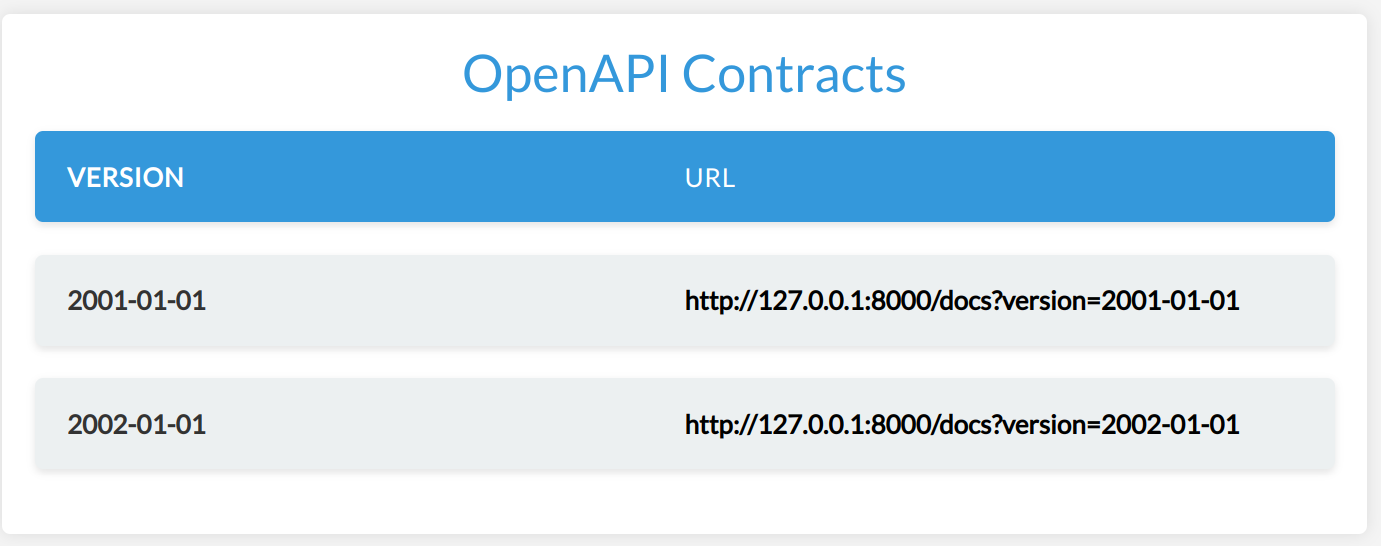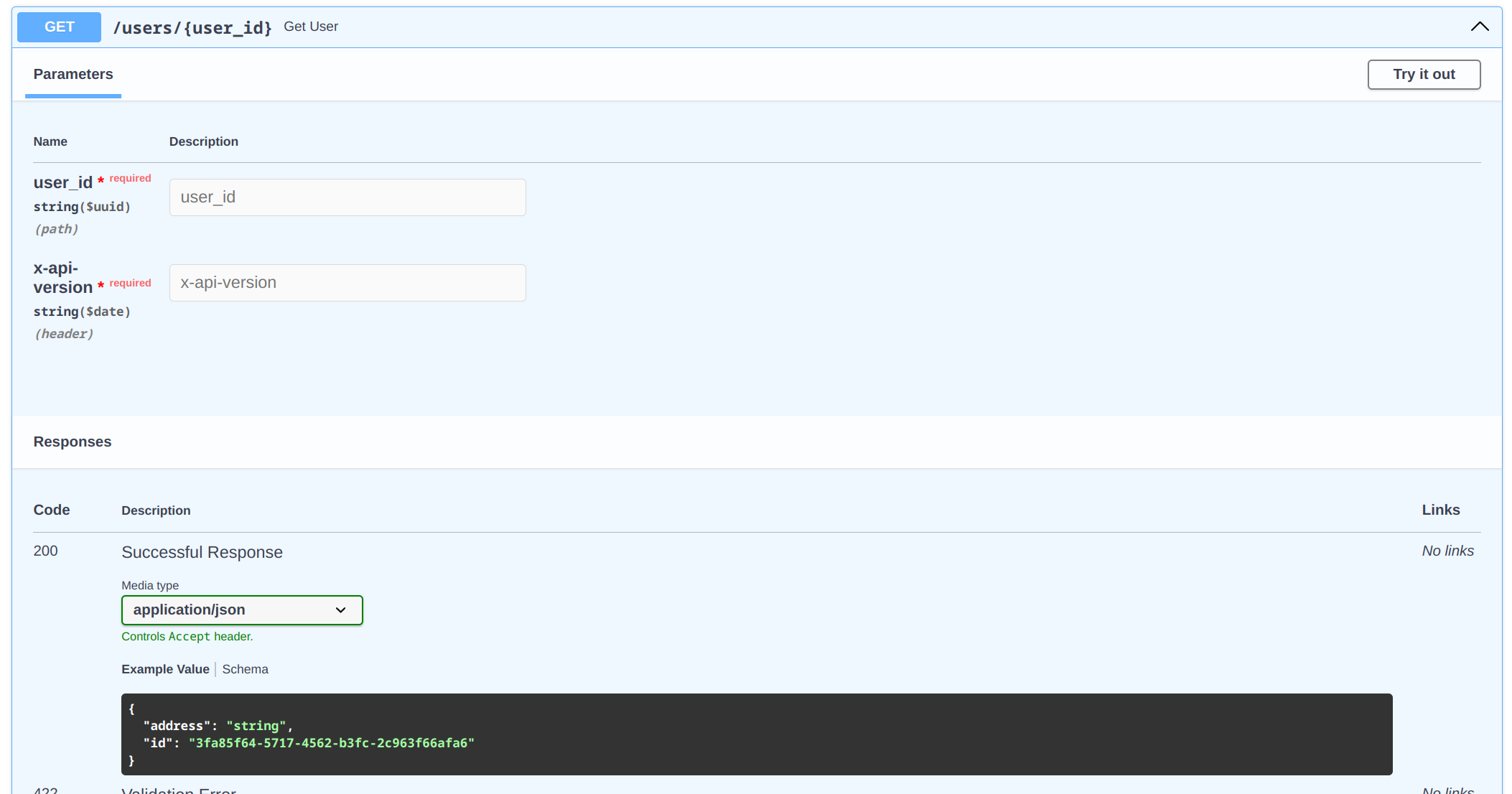Tutorial¶
This tutorial provides steps for setting up automatic API versioning using Cadwyn. This will be illustrated with an example of a User API with changes to a User's address. The advanced version of the service from this tutorial is available here.
Adding a new API version in Cadwyn consists of two main steps:
- Make the breaking change
- Use Cadwyn to describe how to revert the breaking change
This tutorial will show how to prepare an environment for working with Cadwyn effectively in a basic usage example, how to make a breaking change, and how Cadwyn can help to keep the old API versions untouched.
Step 0: Setting up¶
Here is an initial API setup where a User has a single address. The example implements two routes - one for creating a User and the other for retrieving User details. User ID is implemented as int for simplicity. Please note that a dict is used in place of a database for simplicity but do not ever do it in real life.
The first API one comes up with usually doesn't require more than one address -- why bother?
import uuid
from pydantic import BaseModel
from cadwyn import (
Cadwyn,
Version,
VersionBundle,
VersionedAPIRouter,
)
class UserCreateRequest(BaseModel):
address: str
class UserResource(BaseModel):
id: uuid.UUID
address: str
database_parody = {}
router = VersionedAPIRouter()
@router.post("/users")
async def create_user(payload: UserCreateRequest) -> UserResource:
id_ = uuid.uuid4()
database_parody[id_] = UserResource(id=id_, address=payload.address)
return database_parody[id_]
@router.get("/users/{user_id}")
async def get_user(user_id: uuid.UUID) -> UserResource:
return database_parody[user_id]
app = Cadwyn(versions=VersionBundle(Version("2000-01-01")))
app.generate_and_include_versioned_routers(router)
If you visit /docs, you will see the following dashboard:

The app is ready for use. To call its endpoints, pass X-API-VERSION header with value equal to 2000-01-01. But this is just one version. For a breaking change, Cadwyn supports multiple versioning styles, including header-based, path-based, and number-based.
Step 1: Making the breaking change¶
Assume that during the development you realize that the initial API design is wrong and that address should be addresses so that the User can have several addresses to choose from. So now you want to change the type of the addresses field to a list of strings.
import uuid
from typing import Annotated
from pydantic import BaseModel, Field
from cadwyn import (
Cadwyn,
Version,
VersionBundle,
VersionedAPIRouter,
)
class UserCreateRequest(BaseModel):
addresses: list[str]
class UserResource(BaseModel):
id: uuid.UUID
addresses: Annotated[list[str], Field(min_length=1)]
database_parody = {}
router = VersionedAPIRouter()
@router.post("/users")
async def create_user(payload: UserCreateRequest) -> UserResource:
id_ = uuid.uuid4()
database_parody[id_] = UserResource(id=id_, addresses=payload.addresses)
return database_parody[id_]
@router.get("/users/{user_id}")
async def get_user(user_id: uuid.UUID) -> UserResource:
return database_parody[user_id]
app = Cadwyn(versions=VersionBundle(Version("2001-01-01")))
app.generate_and_include_versioned_routers(router)
Now your users will have their API integration broken. To prevent that, introduce API versioning. There aren't many methods of doing that. Most of them force you to either duplicate your schemas, your endpoints, or your entire app instance. And it makes sense, really: duplication is the only way to make sure that you will not break old versions with your new versions; the bigger the piece you are duplicating, the safer. Of course, the safest being duplicating the entire app instance and even having a separate database. But that is expensive and makes it either impossible to make breaking changes often or to support many versions. As a result, either you need infinite resources, very long development cycles, or your users need to migrate often from version to version.
Stripe has come up with a solution: to have one HEAD app version whose responses get migrated to older versions and to describe changes between these versions using migrations. This approach allows Stripe to keep versions for years without dropping them. Obviously, each breaking change still hurts and each version still makes the system more complex and expensive, but their approach gives you a chance to minimize this complexity. Additionally, it allows you to backport features and bugfixes to older versions. However, you will also be backporting bugs, which is a sad consequence of eliminating duplication.
Assume you need to know what your code looked like two weeks ago. You may use git checkout or git reset with an older commit because git stores the latest version of your code (which is also called HEAD) and the differences between it and each previous version as a chain of changes. This is exactly how Stripe's approach works. They store the latest version and use the diffs to regenerate the older versions.
Cadwyn is built upon this approach, so let's continue with the tutorial and combine the two versions that were created using versioning.
Note to curious readers
Git doesn't actually work this way internally. The description above is closer to how SVN works. It's a simplistic metaphor to explain a concept.Step 2: Describing how to revert the breaking change¶
To fix the old integrations of your clients, you need to add back the 2000-01-01 version and its state. In Cadwyn, it is done using version changes (or, as Stripe calls them, version gates). You could also think of them as reverse database migrations (database migrations to downgrade to the previous state of the database). Essentially version changes describe the difference between the latest version and the previous version. They are a way to say "Okay, we have applied the breaking changes but here is how we would revert these changes for our old clients".
For every endpoint whose response_model is UserResource, this migration will convert the list of addresses back to a single address when migrating to the previous version. Your goal is to have an app of HEAD version and to describe what older versions looked like in comparison to it. That way the old versions are frozen in migrations and you can almost safely forget about them.
import uuid
from typing import Annotated
from cadwyn import (
Cadwyn,
RequestInfo,
ResponseInfo,
Version,
VersionBundle,
VersionChange,
VersionedAPIRouter,
convert_request_to_next_version_for,
convert_response_to_previous_version_for,
schema,
)
from pydantic import BaseModel, Field
class UserCreateRequest(BaseModel):
addresses: list[str]
class UserResource(BaseModel):
id: uuid.UUID
addresses: Annotated[list[str], Field(min_length=1)]
database_parody = {}
router = VersionedAPIRouter()
@router.post("/users")
async def create_user(payload: UserCreateRequest) -> UserResource:
id_ = uuid.uuid4()
database_parody[id_] = UserResource(id=id_, addresses=payload.addresses)
return database_parody[id_]
@router.get("/users/{user_id}")
async def get_user(user_id: uuid.UUID) -> UserResource:
return database_parody[user_id]
class ChangeAddressToList(VersionChange):
description = (
"Give user the ability to have multiple addresses at the same time"
)
instructions_to_migrate_to_previous_version = (
schema(UserCreateRequest)
.field("addresses")
.had(name="address", type=str),
schema(UserResource).field("addresses").had(name="address", type=str),
)
@convert_request_to_next_version_for(UserCreateRequest)
def change_address_to_multiple_items(request: RequestInfo):
request.body["addresses"] = [request.body.pop("address")]
@convert_response_to_previous_version_for(UserResource)
def change_addresses_to_single_item(response: ResponseInfo) -> None:
response.body["address"] = response.body.pop("addresses")[0]
app = Cadwyn(
versions=VersionBundle(
Version("2001-01-01", ChangeAddressToList),
Version("2000-01-01"),
)
)
app.generate_and_include_versioned_routers(router)
See how the first address is popped from the list? This is guaranteed to be possible if you specified earlier that min_length for addresses must be 1. If you didn't, then a user would be able to create a User in a newer version that would be impossible to represent in the older version. I.e. if anyone tried to get that user from the older version, they would get a ResponseValidationError because the user wouldn't have data for a mandatory address field. You need to always keep in mind that API versioning is only for versioning your API, your interface. Your versions must still be completely compatible in terms of data. If they are not, then you are versioning your data and you should go with a separate app instance. Otherwise, your users will have a hard time migrating back and forth between API versions and many unexpected errors.
Also note that the migration was added not only for the response but also for the request. This will allow your business logic to stay completely the same, no matter which version it was called from. Cadwyn will always give your business logic the request model from the HEAD version by wrapping each request in it.
Run the app and take a look at the generated dashboard and OpenAPI schemas:


The endpoint above is from the 2000-01-01 version. As you see, your routes and business logic are for the HEAD version but your OpenAPI has all the information about all the API versions which is the main goal of Cadwyn: a large number of long-living API versions without placing any burden on your business logic.
Obviously, this was just a simple example and Cadwyn has a lot more features so if you're interested -- take a look at the how-to and concepts sections.